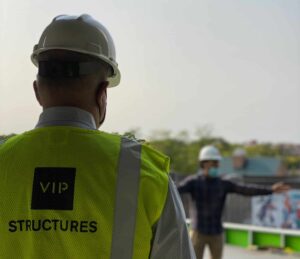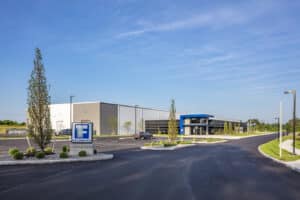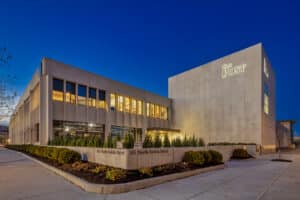The design-build and construction industry is always evolving. Both processes and the materials that go into those processes are constantly being evaluated to create more effective and efficient outcomes. “Super materials” have multifunctional traits, meaning they can give a building the power to clean the environment, repair itself, and much more. Researchers creating materials with these traits hold the shared objective to improve construction methods and make the built environment more sustainable.
So what is it that is suddenly enabling us to produce more specialized and advanced materials? Material innovation is covered extensively in Blane Brownell’s newest book, “Transmaterial: Next.” In the book, he covers the latest and greatest materials that exhibit transformative potential over conventional versions and are on a path toward commercialization. Hundreds of new materials and applications are in the pipeline for the construction industry.
For example, 100% commercial-ready materials like Newspaper Wood, which is a wood-like material made from recycled newspapers. Below, we have compiled five of our favorites that are closer to the commercial-ready stage of material development.
Expect these game-changing materials to make their way into the integrated design-build and construction process in the next decade.
Bendable Concrete
A major drawback to concrete is its brittleness. This is why concrete is so frequently reinforced with steel (rebar). Rebar helps to prevent cracking, structural failure, or both. Up until now, there were not many options to fix the brittleness dilemma beyond using a type of reinforcement.
Researchers are now developing a bioconcrete that repairs itself and a bendable concrete. The latter is being investigated at the University of Michigan’s Advanced Civil Engineering Materials Research Lab. Researchers at Michigan have created a cementitious composite (ECC) that is made with thousands of short-coated microfibers.
This bendable super concrete can withstand four times the tensile force of its standard counterpart. It is coined as “bendable” because it also has three-hundred times the ductility of regular concrete. Test applications of the ECC material have already been successfully installed on high-rise buildings, as well as highways.

Curface
Figuring out how to innovatively reuse or upcycle discarded waste is a difficult task to tackle in the construction industry. What’s even harder is figuring out how to find a solution while also achieving an aesthetically pleasing material. UK firms, like Re-worked and Smile Plastics, are teaming up to find a solution to this.
Their new material, “Curface,” is made of 40% recycled coffee grounds in combination with recycled plastic and bioresin. The finished product is a beautiful granite-like smooth surface that has the strength and durability of hardwood. Applications for Curface mainly include appliance surroundings and tabletops. These would be excellent and sustainable options for new or refurbished apartment buildings or condominiums.

E Ink Prism
A simple wall was something that was once always considered to be a static element. However, thanks to recent innovations in lighting and digital technologies, the standard wall might be changing. The E Ink Prism, developed by E Ink Holdings Inc., creates continuously transforming architectural surfaces using bi-stable electronic ink film. This ink is comprised of printing industry pigments (similar to paint), but is configured to disappear and reappear upon user interaction.
Since the wall is a tile-based system, you could potentially “turn on” only a few tiles at a time – producing a mosaic tile color effect. This low-power wall interface holds the potential to completely transform how users interact with interior spaces.
By turning your wall into this textual information canvas, users are virtually unlocking limitless design possibilities. Imagine an office space that changes colors based on the type of activity being performed by its occupants. What color or pattern would a conference room embody versus a break room?
Wondering if there is a right way to design office space for productivity? Learn more.

SolarLeaf
Recent technological advancements have enabled us to create thinner and more translucent materials. This has increased the possibilities for generating energy right inside the façade itself without losing window transparency.
The world’s first bioreactive façade has been developed by Arup Engineers in close partnership with the Strategic Science Consult of Germany and Colt International. The team worked on this living façade for the 2013 International Building Exhibition in Hamburg.
The curtain wall system consists of four layers of argon-insulated glass, water, algae culture, growth medium, plastic scrubbers, compressed air, and inflow and outflow pipes. When sun shines down on the façade, the algae biomass grows and generates renewable power. This power is transferred via heat within a closed-loop system to a building energy management center, which harvests the algae biomass and the heat via a heat exchanger.
NeptuTherm
This list of new-age building materials wouldn’t be complete without an improved type of insulation. Researchers at the Fraunhofer Institute for Chemical Technology have created and helped commercialize seaweed insulation. The Posidonia oceanica seaweed, also known as Neptune grass, is a widely abundant natural material that has a high insulating value as well as strong mold resistance and low flammability.
After the team at Fraunhofer realized its properties, they created a method for processing the material, which enables it to be used for blown insulation applications in walls, roofs, and ceilings.
What makes this product even more impressive is that NeptuTherm (the commercial product) does not require any chemical additives, which is a welcomed plus for building projects aiming to achieve green building certifications such as LEED.
Materials with a purpose
Besides being technologically advanced or a first of its kind in some way, most of these materials were developed with the intention of becoming a more sustainable version of their current counterpart. These game-changing materials are more effective and efficient versions of the same materials and structures currently being used every day by design-build firms.
Materials are evolving into “super materials” not only because they are smart or have multifunctional properties, but because creators are actively pursuing a way to drastically improve our built environment into one that doesn’t involve a massive amount of carbon emissions, pollution from manufacturing and construction, and/or off-gassing of chemicals.
Interested in learning more about new building materials? In a previous post, we discussed the innovative use of building materials.
Learn more about VIP Structures and how our integrated design-build company in Syracuse, NY can assist with your next project. Contact us below.
Liked this post? Share it on Twitter and LinkedIn.



